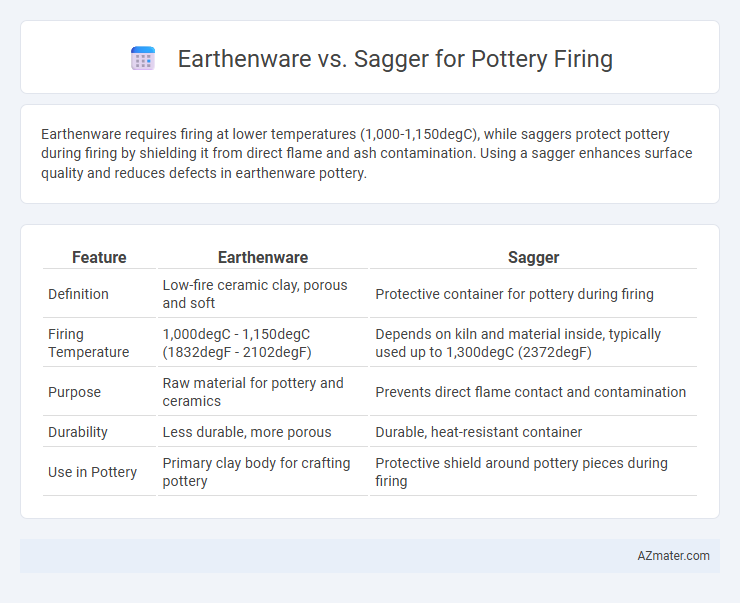Earthenware requires firing at lower temperatures (1,000-1,150degC), while saggers protect pottery during firing by shielding it from direct flame and ash contamination. Using a sagger enhances surface quality and reduces defects in earthenware pottery.
Table of Comparison
| Feature | Earthenware | Sagger |
|---|---|---|
| Definition | Low-fire ceramic clay, porous and soft | Protective container for pottery during firing |
| Firing Temperature | 1,000degC - 1,150degC (1832degF - 2102degF) | Depends on kiln and material inside, typically used up to 1,300degC (2372degF) |
| Purpose | Raw material for pottery and ceramics | Prevents direct flame contact and contamination |
| Durability | Less durable, more porous | Durable, heat-resistant container |
| Use in Pottery | Primary clay body for crafting pottery | Protective shield around pottery pieces during firing |
Understanding Earthenware and Sagger: Key Definitions
Earthenware is a porous clay body fired at lower temperatures, typically between 1,000degC and 1,150degC, known for its earthy tones and rustic finish. A sagger is a protective container made from refractory materials used in pottery firing to shield delicate pieces from direct flame, ash, or chemical fumes. Understanding the functions and firing requirements of earthenware and saggers is essential for achieving desired ceramic durability and aesthetic quality.
Historical Evolution of Earthenware and Sagger Usage
Earthenware, one of the oldest forms of pottery, dates back to prehistoric times and has been widely used across ancient civilizations due to its ease of production and porous nature. The use of saggers evolved as a protective container in kilns to shield earthenware from direct flame, ashes, and kiln debris, enhancing the quality and appearance of the fired pottery. This development reflects technological advancements in ceramic firing methods, allowing for more controlled atmospheres and improved durability of earthenware artifacts over time.
Material Composition: Earthenware vs Sagger
Earthenware is primarily composed of natural clay mixed with varying amounts of sand and other minerals, making it porous and fired at lower temperatures between 1,000degC and 1,150degC. Sagger, in contrast, is a protective container made from refractory materials such as fireclay and alumina, designed to encase pottery during firing and shield it from direct flame and ash contamination. While earthenware forms the actual pottery body, saggers serve as external ceramic shields that facilitate controlled firing environments and enhance surface finishes.
Firing Methods: Open Firing vs Sagger Firing
Earthenware firing typically utilizes open firing methods, exposing pots directly to flames and atmosphere, which can produce unpredictable results and surface variations. Sagger firing involves placing pottery inside a protective container, or sagger, during firing to shield pieces from direct contact with flames, ash, and debris, allowing for greater control over the kiln atmosphere and surface finish. This method reduces contamination risks and can alter oxidation and reduction conditions, enhancing the final aesthetic and durability of earthenware ceramics.
Temperature Ranges and Their Impact
Earthenware typically fires at lower temperatures between 1,000degC to 1,150degC, resulting in porous, less vitrified ceramics that are ideal for decorative pottery and terracotta. Saggers withstand higher temperatures, often around 1,200degC to 1,300degC, protecting delicate pieces from direct flame and atmosphere effects, which enhances durability and surface quality. The firing temperature profoundly impacts the ceramic's hardness, porosity, and color, making the choice between earthenware and saggers crucial for achieving desired functional and aesthetic results.
Surface Effects and Color Outcomes
Earthenware firing typically results in porous, matte surfaces with warm, natural earth tones due to oxidation in open kilns. Sagger firing, involving a protective container, creates unique surface effects by shielding pots from direct flame and ash, enabling vibrant colors and textures from controlled atmospheres and flux interactions. The use of saggers can produce delicate variations in glaze and clay body colors unattainable with standard earthenware firing methods.
Durability and Functionality Comparisons
Earthenware is a porous ceramic fired at lower temperatures, offering moderate durability but often requiring glazing for functionality in holding liquids. Sagger firing involves enclosing pottery in a protective container during high-temperature firing, enhancing the durability of both earthenware and stoneware by preventing direct flame and ash contact. The protective environment of saggers improves surface quality and functionality, making sagger-fired pieces more resistant to chipping and thermal shock compared to standard earthenware.
Artistic and Decorative Possibilities
Earthenware offers vibrant color retention and smooth glazing, making it ideal for detailed artistic expressions and decorative pottery with rich surface textures. Sagger firing enhances creative possibilities by providing a controlled, smoke-enclosed environment that produces unique, unpredictable patterns and organic finishes, adding depth and character to the ceramics. Combining earthenware clay with sagger firing techniques allows artists to explore diverse aesthetic outcomes, from rustic to refined decorative effects.
Cost and Accessibility for Potters
Earthenware firing typically requires lower temperatures, reducing fuel costs and making it more accessible for potters with limited resources, while saggers demand higher heat and specialized materials that increase overall expenses. The affordability of earthenware clay and the simplicity of open or pit firing methods make it a cost-effective choice for beginners and small-scale artisans. Conversely, saggers offer protection during firing but involve additional investment in durable refractory containers and kilns capable of higher temperatures, limiting accessibility for some potters.
Choosing Between Earthenware and Sagger: Practical Recommendations
Choose earthenware firing for projects demanding porous, low-temperature ceramics with vibrant glaze outcomes, ideal for decorative pottery and functional wares. Opt for sagger firing when protecting pieces from direct flame and ash is essential, enhancing surface textures and color variations through controlled atmospheres. Consider kiln type, desired aesthetic effects, and firing temperature ranges--earthenware typically fires between 1000-1150degC, while saggers require precise placement and protective materials for higher or specialized firing conditions.

Infographic: Earthenware vs Sagger for Pottery Firing
 azmater.com
azmater.com